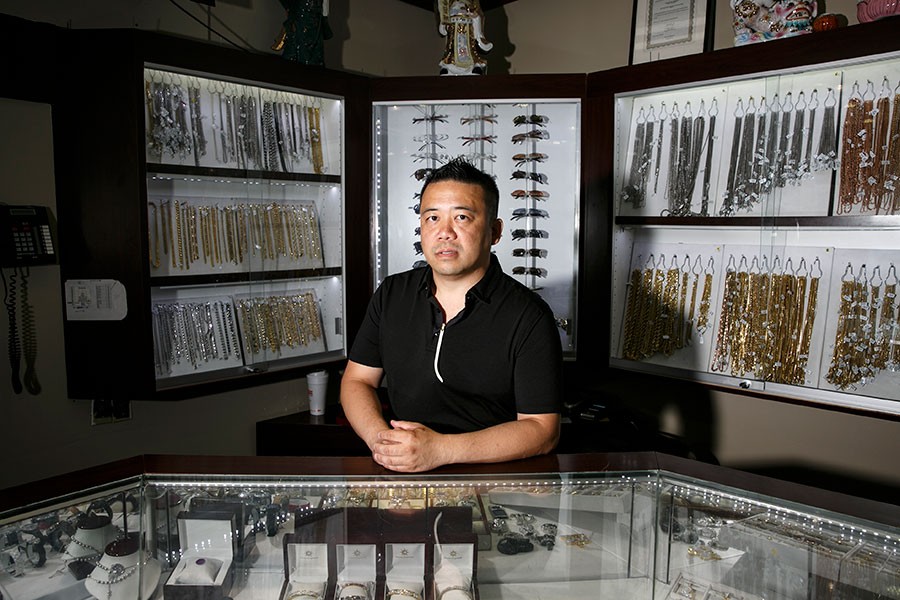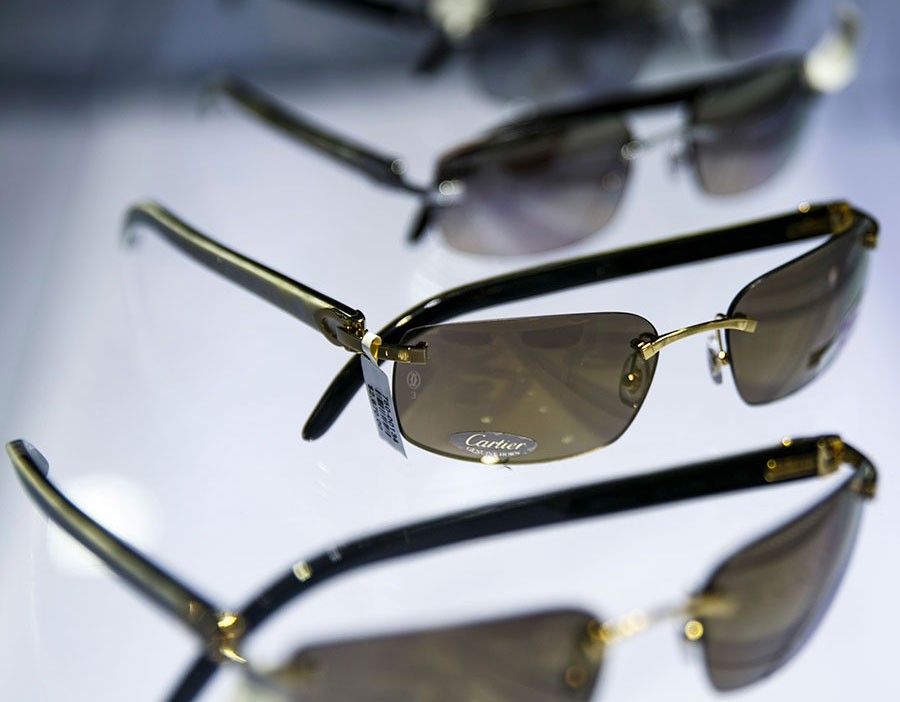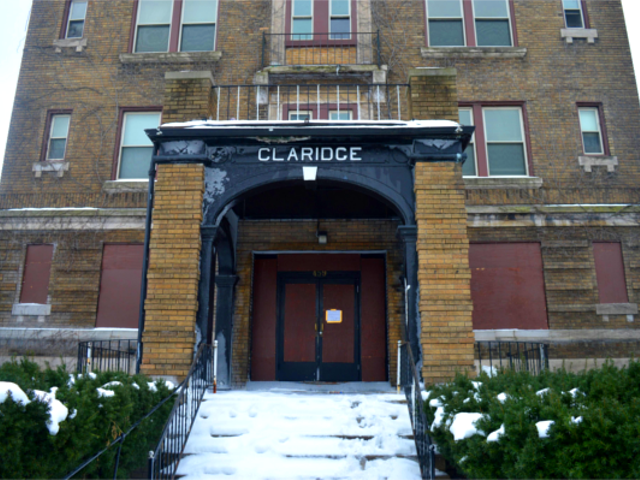
"You think 'em wire frames shining? / I'll be at the pawn shop before this rhyme end."
—"Cartier" by Danny BrownWhile AuCourant has changed ownership and is now called Optica, it remains the centerpiece of Detroit's Cartier economy, one that extends to pawnshops, unauthorized dealers, independent distributors, vintage retailers, customization specialists, and an enormously profitable black market.
In two years, the Somerset store lost $200,000 worth of Cartier glasses to theft, many of which are likely still in circulation. "My friends were held up at gunpoint and handcuffed in the back," says Rosenberg, explaining how a mix of grand theft, shoplifting, credit card fraud, and regular snatch-and-grabs feed the underground Cartier distribution circuit. "And another time right at closing, these kids came in, put a gun to my coworker's head, and cleaned out the entire case. We had a video camera, but they took that too."
According to a Cartier sales associate, only 33 pairs of White Buffalo horn Cartier glasses are available at authorized retailers worldwide. The anonymous Detroit employee compares them to the ring in The Lord of the Rings: "They become possessed by it. The money, the prestige. I've worked with people that have literally committed theft on their way out the door.'"
"I ran out of Somerset mall in Troy, Michigan, with my first pair," says The General, a gaunt but imposing figure who also refers to himself as the Cartier King because of the number of glasses he claims to have stolen and sold over the years. "Got caught for it a year later."
An anonymous Detroit employee compares Cartiers to the ring in The Lord of the Rings: ‘They become possessed by it.’
tweet this
With an FN Five-seven handgun loaded with a 30-round extended magazine in his lap, The General drives his white BMW to a trap house to pick up two Percocets for $20. When we arrive, the man selling pills is sitting on his front stoop wearing Cartier Giverny wire frames. He describes them as "more professional" than the White Buffs that The General has on. After all, he is currently working his 9-5.
"They will look at [White Buffs] and think: dope dealer or rapper," the man explains. "I learned young. I walked [into court] before with White Buffs. Went back to jail. And the bailiff told me it was because I looked like a drug dealer. Because you walk into court and you say you don't have a job, but you've got on $2,500 glasses."
Back in the car, The General complains that the younger generation preserving the practice of Cartier snatching doesn't have a clue what they're doing. "They done robbed people for they glasses and left 'em with a $50,000 watch on. For some $3-$4,000 glasses?! All they know is Cartiers. They hear all the music with the Cartiers. That's what they grow up listening to. That's what they fucking want."
“Continue to smoke / Looking through my Cartier frames / Counting change / Really don’t fuck with no loc.”
—“Uncle Jesse James” by StreetlordzDetroit hip-hop and rap lyrics in particular played a vital role in educating young men on Cartier culture. Frequent Eminem collaborator Royce da 5'9", who's almost never photographed without a Detroit Tigers hat and some Cartier frames, mentions them on songs like "Shake This": "On some couple thousand-dollar suit type shit / From behind thousand-dollar Cartier scrips." One underground group called Bandgang refers to themselves as "The White Buff Boyz," although, as their manager told me, they recently had all of their glasses confiscated in a federal raid. And in an early track from rapper Danny Brown called "Cartier," he raps, "And I think them wood frames better on me / Sold 'em for six, coulda got a G." Thanks to artists like these, Cartier has received a wealth of free advertising, and, according to Rosenberg, the music has actually translated into revenue.
"The early 2000s is when a lot of the rappers started rapping about the glasses. There was a spike in sales, and during that time, we were the number one Cartier seller in the world," she claims. Much of that free advertising came from the Streetlordz, a locally revered underground group. Not only did they immortalize the style on popular songs like "Uncle Jesse James" and "They Don't Want No Drama," the group's breakout star, Blade Icewood, popularized the practice of putting diamonds on wood Cartier frames — hence the name Icewood.
"All of Blade's jewelry came from us," says Gary Yee, owner and co-founder of Golden Sun Jewelry, a custom jeweler that specializes in Cartier products. As Gary gently puts down a tray of approximately $90,000 worth of Russian cut diamonds, he explains that for $3,800 and up — on top of the $2,650 retail price for White Buffs — he will expertly solder the nose bridge with solid 14-karat gold. Then, he'll embed diamonds in the bridge, the temple bracket, and finally, the signature Cartier 'C.'
"People got sick and tired of everyone in Detroit having the same Cartier glasses. It's like, 'I spent all this amount of money and everyone else is onto it,'" he tells me as one of his employees finishes assembling a fresh pair of diamond buffalo horn Cartiers. Iced Buffs are so popular that Gary has to maintain a backlog of $6,450-plus frames. "Each day," he says, "we sell an average of 8-10 pieces of Buffalos."
Before the Streetlordz garnered any significant national acclaim, Blade Icewood was killed as the apparent result of beef with a rival crew called the Eastside Chedda Boyz. According to locals, the initial argument that led to Blade's death stemmed from a dispute over ownership of the name "Chedda Boyz." Soon after, Street Lord Juan went to prison on drug charges, where he remains to this day. Street Lord Rook got locked up too, and only a couple of weeks after his release, he was at a gas station when he watched his friend get shot in the back over a pair of Carties.
Today, Detroit is seeing small but meaningful improvements in its decades-long struggle with violent crime. Not only that, but the population decline is slowing and jobs are coming back. But who benefits from a more prosperous Detroit? At Zeidman's, one of Detroit's oldest pawn shops, I meet a 23-year-old white customer wearing a black python skin Balenciaga backpack that retails for around $3,450. He's looking for some vintage Cartier frames to add to the four-pair collection he's amassed in the year since moving from Chicago to Detroit. Beginning in 2015, there's been an uptick of affluent white transplants that's left longtime residents uneasy.
"I always liked nice sunglasses," the kid tells me, "and now I can afford them. I work in the legal weed business and business has been good this year."
As he buys yet another pair of Cartier sunglasses made popular by the Streetlordz, one of the group's founding members, Rook, is rebuilding his life after his recent release from a four-year prison stint for conspiracy to sell marijuana.
Not long after the Streetlordz disbanded, a crew of ambitious high school students from the Westside who called themselves Doughboyz Cashout stepped in to fill the void as the city's newest underground artists and as Cartier's unofficial spokesmen. Much like Doughboyz's former label boss Jeezy, they make music to motivate people and often seem more focused on the fruits of their hustle than the details of the hustle itself. They dress fresh and drive the best cars in the Motor City, both because it's fun and because they want to send a message that they're free from the poverty that gnaws away at the neighborhoods that raised them.







